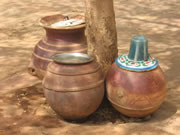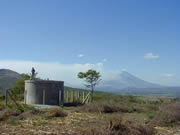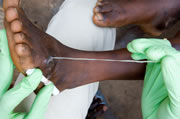CDC Global WASH Programs and Projects
Safe Water System
In areas where access to safe water, appropriate wastewater management, and adequate sewer systems is not feasible, certain programs, such as CDC's Safe Water System, can empower people to improve and protect the quality of their household drinking water through simple, inexpensive technologies to treat and safely store water in their homes. The intervention consists of these steps:
- Point-of-use treatment of contaminated water
- Safe water storage
- Improved hygiene
- Behavior change techniques

Photo courtesy of D. Lantagne
For smaller community-based organizations, technical information on developing household water treatment and safe water storage programs can be found online within the Bibliography of Point-of-Use Water Disinfection. Also available online is the document Safe Water for the Community: A Guide for Establishing a Community-Based Safe Water System Program ![]() (PDF, 660 kb, 62 pages); this guide can also be obtained in hard-copy with a CD by sending an email to safewater@cdc.gov (1).
(PDF, 660 kb, 62 pages); this guide can also be obtained in hard-copy with a CD by sending an email to safewater@cdc.gov (1).
Global Water, Sanitation, and Hygiene Program (Global WASH) at the National Center for Environmental Health (NCEH)

Photo courtesy of R. Gelting
In communities where water, sanitation construction, and hygiene education are feasible interventions, the Global Water, Sanitation, and Hygiene (Global WASH) program at CDC’s National Center for Environmental Health (NCEH) collaborates with partner organizations to improve the public health effects and sustainability of these environmental conditions. The program also provides technical assistance to support water, sanitation, and hygiene development and implementation.
Currently, the Global WASH program at NCEH:
- Evaluates the sustainability of water, sanitation, and hygiene interventions such as the Central America Water and Sanitation Sustainability Project;
- Improves access to safe drinking water through Water Safety Plans (WSPs); and
- Researches the public health impacts of sanitation programs.
More information on community water systems and water safety plans is available from CDC's Water Safety Plans and from the World Health Organization (WHO) at WSPortal: Health through Water. Technical information on developing water safety plans can be found from WHO at Water Safety Plans: Managing Drinking-Water Quality from Catchment to Consumer.
Guinea Worm Eradication Program

Photo courtesy of The Carter Center
For more information on Guinea Worm Disease, visit:
- Carter Center’s Guinea Worm Eradication Program
- CDC’s Guinea Worm Disease website
1. Lantagne DS, Gallo W. Safe Water for the Community: A Guide for Establishing a Community-Based Safe Water System Program. CDC 2008; Edition 1.
2. The Carter Center. Distribution by Country of 9,570 Cases of Dracunculiasis Reported During 2007. Available at http://www.cartercenter.org/resources/pdfs/health/guinea_worm/guinea_worm_cases_country_2007.pdf ![]() .
.
![]() This icon indicates a link leading outside of this CDC Web site. While this external link provides additional information that is consistent with the intended purpose of the Centers for Disease Control and Prevention (CDC), not all external links will lead to federal websites. CDC cannot attest to the accuracy of a non-federal site, and linking to a non-federal site does not constitute an endorsement by CDC or any of its employees of the sponsors or the information and products presented on the site. You will be subject to the destination site’s privacy policy when you follow any link so indicated.
This icon indicates a link leading outside of this CDC Web site. While this external link provides additional information that is consistent with the intended purpose of the Centers for Disease Control and Prevention (CDC), not all external links will lead to federal websites. CDC cannot attest to the accuracy of a non-federal site, and linking to a non-federal site does not constitute an endorsement by CDC or any of its employees of the sponsors or the information and products presented on the site. You will be subject to the destination site’s privacy policy when you follow any link so indicated.
![]() Please note: Some of these publications are available for download only as *.pdf files. These files require Adobe Acrobat Reader in order to be viewed. Please review the information on downloading and using Acrobat Reader software.
Please note: Some of these publications are available for download only as *.pdf files. These files require Adobe Acrobat Reader in order to be viewed. Please review the information on downloading and using Acrobat Reader software.
- Page last reviewed: November 25, 2008
- Page last updated: November 25, 2008
- Content source: Centers for Disease Control and Prevention
Contact Us:
- Centers for Disease Control and Prevention
1600 Clifton Rd
Atlanta, GA 30333 - 800-CDC-INFO
(800-232-4636)
TTY: (888) 232-6348
24 Hours/Every Day - healthywater@cdc.gov

